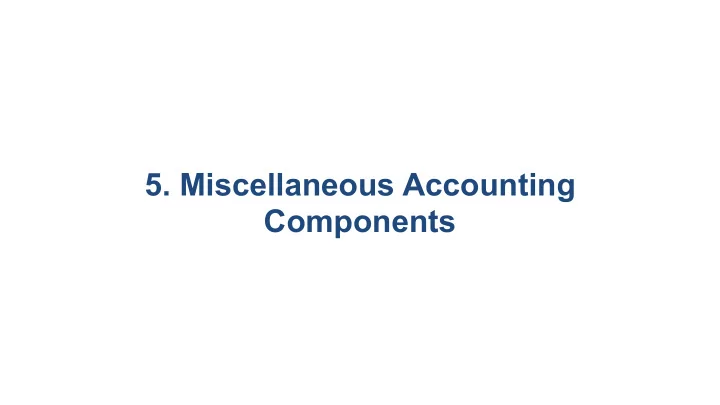

5. Miscellaneous Accounting Components
5.1 Investments 5.2 Contingent Liabilities 5.3 Summary
5.1 Investments
• Investments are uses of a business’s money to buy assets.
• Businesses also possess the option to sell assets
• One type of Investment: • Long-term investments
• Another term representing Long- term: • Held-to-Maturity investments
• Another type of Investment • Short-term investments
• These are also assets, and they may include:
1. Certificates of deposit (CD)
2. Stock
• An investment is any source that can change into cash within, or slightly over one year
• Trading Investments • Available-for-Sale Investments
5.2 Contingent Liabilities
• A Contingent Liability is a potential, yet unknown cost, that may, or may not incur.
• There are three categories of Contingent Liabilities
• High Probability:
• Medium Probability:
• Low Probability:
• Important Example:
• Your client sold a faulty product • Had significant warranty claims as a result.
• Its OK= Low Probability • If your client has: • Isolated the bad product • Recalled it • Settled the related warranty claims
• Chances are LOW for dealing with similar warranty issues on that product in the future.
5.3 Summary
• First, lets talk … ..: • Contingent Liabilities
A Contingent Liability is a: • 1. potential, yet; • 2. unknown cost, that; • 3. may, or may not incur
• These particular liabilities are not recorded in a company's accounts, or shown in the balance sheet, unless:
• The scenario presents these liabilities as both probable, and reasonably estimable as 'contingency‘, or; • deemed 'worst case' financial outcome.
Three examples of contingent liabilities include: 1.Warranty of a company's products 2.The guarantee of another party's loan, and; 3.Lawsuits filed against a company
• There are three categories of Contingent Liabilities
High Probability: the costs can be estimated and loss must be disclosed and described in financial statements.
High Probability example: • Property • Mortgage, home improvement, a catastrophe, or a sale will deem allow for a cost to be estimated, and the loss 100% is documented
Medium Probability: costs must be disclosed in statements if the contingency is probable, yet not necessarily probable.
Medium Probability example: • Lawsuits • Sometimes a contingent liability can arise suddenly, catching both management and investors by surprise.
• The billions in liabilities for BP related to the Deep Horizon oil spill and Volkswagen's massive liabilities from its 2015 emissions scandal are two such scenarios
Low Probability: No reporting required due to low likelihood of cost being triggered.
Low Probability example: • Your client sold a faulty product; Had significant warranty claims as a result. • Its OK= Low Probability • If your client has: • isolated the bad product • recalled it • settled the related warranty claims
Chances are LOW for dealing with similar warranty issues on that product in the future.
Recommend
More recommend